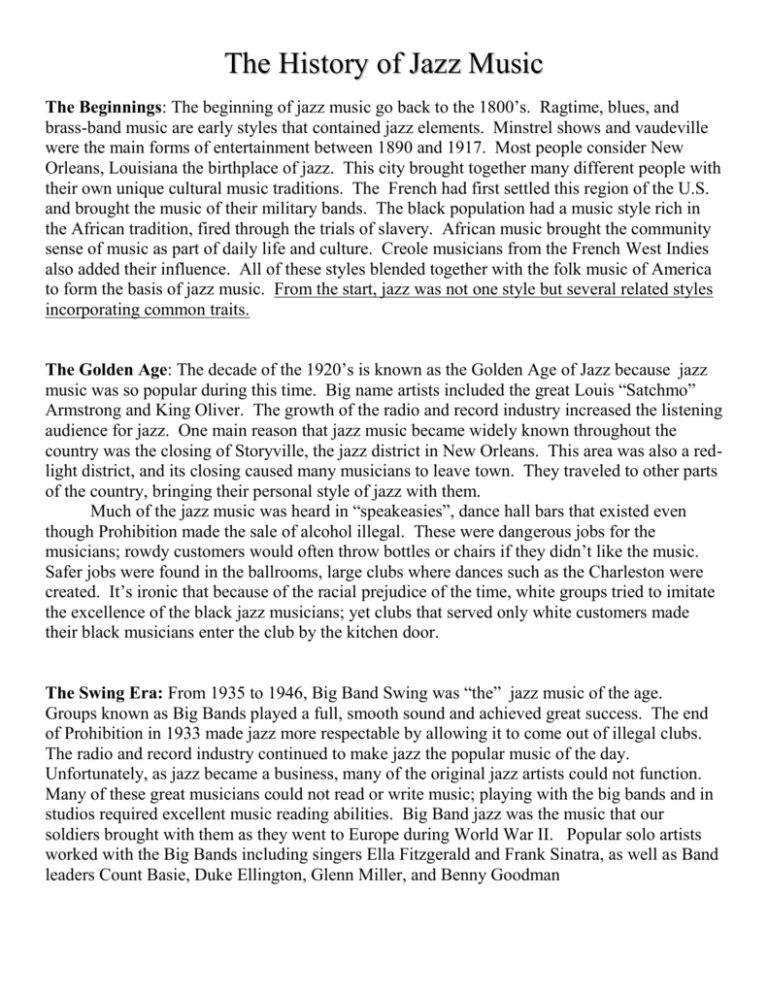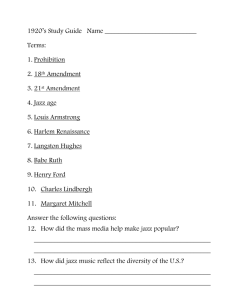Jazz History
advertisement

The History of Jazz Music The Beginnings: The beginning of jazz music go back to the 1800’s. Ragtime, blues, and brass-band music are early styles that contained jazz elements. Minstrel shows and vaudeville were the main forms of entertainment between 1890 and 1917. Most people consider New Orleans, Louisiana the birthplace of jazz. This city brought together many different people with their own unique cultural music traditions. The French had first settled this region of the U.S. and brought the music of their military bands. The black population had a music style rich in the African tradition, fired through the trials of slavery. African music brought the community sense of music as part of daily life and culture. Creole musicians from the French West Indies also added their influence. All of these styles blended together with the folk music of America to form the basis of jazz music. From the start, jazz was not one style but several related styles incorporating common traits. The Golden Age: The decade of the 1920’s is known as the Golden Age of Jazz because jazz music was so popular during this time. Big name artists included the great Louis “Satchmo” Armstrong and King Oliver. The growth of the radio and record industry increased the listening audience for jazz. One main reason that jazz music became widely known throughout the country was the closing of Storyville, the jazz district in New Orleans. This area was also a redlight district, and its closing caused many musicians to leave town. They traveled to other parts of the country, bringing their personal style of jazz with them. Much of the jazz music was heard in “speakeasies”, dance hall bars that existed even though Prohibition made the sale of alcohol illegal. These were dangerous jobs for the musicians; rowdy customers would often throw bottles or chairs if they didn’t like the music. Safer jobs were found in the ballrooms, large clubs where dances such as the Charleston were created. It’s ironic that because of the racial prejudice of the time, white groups tried to imitate the excellence of the black jazz musicians; yet clubs that served only white customers made their black musicians enter the club by the kitchen door. The Swing Era: From 1935 to 1946, Big Band Swing was “the” jazz music of the age. Groups known as Big Bands played a full, smooth sound and achieved great success. The end of Prohibition in 1933 made jazz more respectable by allowing it to come out of illegal clubs. The radio and record industry continued to make jazz the popular music of the day. Unfortunately, as jazz became a business, many of the original jazz artists could not function. Many of these great musicians could not read or write music; playing with the big bands and in studios required excellent music reading abilities. Big Band jazz was the music that our soldiers brought with them as they went to Europe during World War II. Popular solo artists worked with the Big Bands including singers Ella Fitzgerald and Frank Sinatra, as well as Band leaders Count Basie, Duke Ellington, Glenn Miller, and Benny Goodman Bob/Bebop: Changes occurred in the late 1940’s and 1950’s as jazz musicians experimented with their music. Bop was a revolt against the Big Band sound. These jazz artists did what Romantic and 20th century composers tried to do; they broke the rules that most musicians followed in creating their own original music. The styles of people such as Thelonius Monk, Miles Davis, Dizzy Gillespie, John Coltrane and Charlie Parker were complex and challenging to listen to. Artist experimented with new sounds (such as violin, Latin percussion and bagpipes!) and the use of complex African and South American rhythms in their music. At times, Bop could sound very odd and dissonant, and while it was challenging to perform, many listeners preferred the sound of the big bands. While not as popular as other styles, Bop brought a new creative, experimental influence to the jazz world. Rhythm and Blues: (original R&B) also became more popular during the 1950’s and 1960’s with the the music of B.B. King and Ray Charles. This was a direct connection to the African roots and music of the slaves that was the core of early jazz. Call and response, improvisation, and syncopated rhythm were central to the music of the slaves. These styles along with traditional jazz had a deep influence on the early Rock N’ Roll. Many rock and Motown artists of the 50’s and 60’s were trained by jazz musicians. Many early rock artist started out as jazz players themselves. The use of a rhythm section (bass and drums) is taken directly from jazz, as well as the use of familiar riffs and solo improvisation. Free Form/Fusion: Jazz in the 1960’s developed along with the use of electronic musical instruments. Fusion, a combination of jazz and rock, was created in the 60’s.. Artist include Chick Corea, Branford Marsalis, and Herbie Hancock, who composed the song “Axel F” for the movie Beverly Hills Cop. The art of improvising is an important part of rap music in both the speech patterns and the music. Most recently, jazz has inspired the rebirth of R&B and “blue-eyed soul”. Jazz traits can be heard in the music of many groups and artists. Style traits such as improvisation, ABABCB form, syncopated rhythms, chord progressions, and instrumentation are a part of rock, country, rap, hip hop, and R n’ B music. Jazz Today: Jazz today is performed in all of the previous styles (listed above). Neo-Classic Jazz is the latest jazz development ; it’s an interest in the “classic” styles of jazz popular from the 1920’s to the 1950’s. Artists such as Wynton Marsalis and Harry Connick, Jr. have created new music and redone old jazz standards in their own way, imitating the sounds of the earlier jazz era. 90’s Swing, performed by Lou Bega, the Brian Setzer Orchestra, Big Bad Voodoo Daddy, and the Squirrel Nut Zippers has brought jazz to a new generation of listeners. Jazz = constantly changes & evolves in new directions every day Jazz = improvisation + call/response + syncopation built upon a general framework Jazz Roots = African + European/Classical traits + sacred music + folk traditions








